Can you die from electric shock. Electric Shock: Effects, Symptoms, First Aid, and Safety Measures
What are the effects of electric shock on the body. How can you recognize the symptoms of electric shock. When should you seek medical attention after an electric shock. What first aid measures should be taken for electric shock victims. How can you prevent electric shock incidents at home and in the workplace.
Understanding Electric Shock: Causes and Types
Electric shock occurs when an electric current passes through the body, typically from contact with a live electrical source. The severity of the shock can vary widely depending on factors such as the voltage, current type, and duration of exposure. Understanding the causes and types of electric shock is crucial for prevention and proper response.
Common Sources of Electric Shock
- Faulty electrical appliances or machinery
- Household wiring issues
- Electrical power lines
- Lightning strikes
- Exposed electrical outlets
The voltage of electrical sources can range from household levels (110-240V) to industrial power lines carrying over 100,000V. It’s important to note that even low voltage currents can cause significant harm under certain conditions.

Types of Electrical Injuries
Electrical injuries are typically categorized into four main types:
- Flash injuries: Superficial burns caused by the heat of an electrical arc, without current penetration
- Flame injuries: Burns resulting from ignited clothing due to an electrical arc
- Lightning injuries: Short-duration, high-voltage electrical energy passing through the body
- True electrical injuries: When a person becomes part of the electrical circuit, with current entering and exiting the body
The Impact of Electric Shock on the Human Body
The effects of electric shock on the human body can be both immediate and long-lasting. The severity of these effects depends on various factors, including the intensity and type of current, the path it takes through the body, and the duration of exposure.
Short-Term Effects of Electric Shock
Immediate effects of electric shock may include:
- Burns (ranging from superficial to deep tissue damage)
- Irregular heartbeat or cardiac arrest
- Seizures
- Tingling or prickling sensations
- Loss of consciousness
- Headaches
- Muscle spasms
In severe cases, electric shock can lead to coma, heart attack, or respiratory arrest. It’s crucial to understand that the absence of visible injuries doesn’t necessarily mean the person is unharmed.

Long-Term Consequences of Electric Shock
While immediate effects are often apparent, electric shock can also have long-term consequences. These may include:
- Neuropsychological symptoms (e.g., memory problems, cognitive difficulties)
- Chronic pain
- Muscle weakness or paralysis
- Sensory disturbances
- Post-traumatic stress disorder (PTSD)
Interestingly, a study found that people who experienced electric shock were not more likely to develop heart problems within 5 years compared to those who hadn’t. However, this doesn’t diminish the potential for other long-term effects.
Recognizing Electric Shock Symptoms and Severity
Identifying the symptoms of electric shock is crucial for determining the appropriate response and treatment. The severity of symptoms can vary greatly, from mild discomfort to life-threatening conditions.
Mild Electric Shock Symptoms
- Slight tingling sensation
- Muscle twitching
- Minor burns or redness at the point of contact
- Temporary numbness or pins and needles feeling
Moderate to Severe Electric Shock Symptoms
- Severe burns (both external and internal)
- Muscle pain and contractions
- Difficulty breathing
- Confusion or disorientation
- Seizures
- Irregular heartbeat
- Loss of consciousness
How can you determine the severity of an electric shock? Consider the following factors:

- Voltage of the electrical source
- Duration of contact with the electrical current
- Path the current took through the body
- Presence of visible burns or other injuries
- The person’s overall health and age
Is immediate medical attention always necessary after an electric shock? While minor shocks from household appliances may not require professional medical care, it’s always safer to consult a healthcare provider, especially if there are any signs of burns, persistent pain, or cardiac symptoms.
First Aid for Electric Shock Victims
Knowing how to provide first aid to electric shock victims can be life-saving. Here are the essential steps to follow:
- Ensure your own safety: Do not touch the person if they’re still in contact with the electrical source.
- Turn off the power source: If possible, switch off the electricity at the mains or circuit breaker.
- Call emergency services: Seek professional medical help immediately for moderate to severe shocks.
- Check for responsiveness: If the person is unconscious, check for breathing and pulse.
- Begin CPR if necessary: If there’s no pulse or breathing, start cardiopulmonary resuscitation.
- Treat visible burns: Cover burns with sterile gauze or a clean cloth. Do not apply ointments.
- Keep the person still: Minimize movement to prevent further injury.
- Monitor vital signs: Keep checking breathing and pulse until help arrives.
What should you avoid doing when helping an electric shock victim? Never attempt to move a person who is still in contact with a live electrical source. Also, avoid giving food or drink to the victim, as this may complicate emergency medical procedures.

Prevention Strategies: Minimizing Electric Shock Risks
Prevention is always better than cure when it comes to electric shock. Implementing safety measures can significantly reduce the risk of electrical accidents both at home and in the workplace.
Home Safety Measures
- Regular electrical system inspections
- Use of ground fault circuit interrupters (GFCIs) in wet areas
- Proper use and maintenance of electrical appliances
- Childproofing outlets and electrical cords
- Avoiding overloaded circuits
Workplace Electrical Safety
- Comprehensive electrical safety training for employees
- Regular equipment maintenance and inspections
- Use of appropriate personal protective equipment (PPE)
- Implementation of lockout/tagout procedures
- Clear labeling of electrical hazards
How can you create an electrically safe environment? Start by conducting a thorough assessment of your home or workplace to identify potential electrical hazards. Address any issues promptly and establish regular maintenance routines. Education is also key – ensure that all family members or employees understand basic electrical safety principles.

High-Risk Occupations and Industries for Electric Shock
While electric shock can occur in any setting, certain occupations and industries carry a higher risk. Understanding these high-risk areas can help in implementing targeted safety measures and raising awareness among workers.
Occupations with Increased Electric Shock Risk
- Electricians and electrical engineers
- Construction workers
- Utility workers (especially those dealing with power lines)
- Maintenance and repair technicians
- Factory workers in manufacturing industries
Industries with Higher Incidence of Electrical Injuries
According to statistics, the following industries have a higher incidence of nonfatal electrocutions:
- Construction
- Leisure and hospitality
- Education and health services
- Accommodation and food services
- Manufacturing
Why do these industries have higher rates of electrical injuries? Several factors contribute, including frequent interaction with electrical systems, exposure to high-voltage equipment, and sometimes inadequate safety training or protective measures. In construction, for instance, the combination of temporary power setups, exposed wiring, and wet conditions can create hazardous situations.

How can workers in high-risk industries protect themselves from electric shock? Key strategies include:
- Rigorous adherence to safety protocols and procedures
- Regular and comprehensive safety training
- Use of appropriate personal protective equipment (PPE)
- Maintaining a safety-first mindset and reporting potential hazards
- Staying updated on industry-specific electrical safety standards
The Science Behind Electric Shock: Current, Voltage, and Resistance
Understanding the scientific principles behind electric shock can provide valuable insights into its effects and how to prevent it. Three key concepts are central to this understanding: current, voltage, and resistance.
Current: The Flow of Electricity
Electric current, measured in amperes (A), is the flow of electric charge. In the context of electric shock, it’s the current that determines the severity of the shock. Even small currents can be dangerous:
- 0.2-2 mA: Slight tingling sensation
- 1-5 mA: Painful shock, possible loss of muscular control
- 6-30 mA: Painful shock, loss of muscular control, difficulty breathing
- 50-100 mA: Possible ventricular fibrillation, respiratory arrest
- 100+ mA: Severe burns, cardiac arrest, likely death
Voltage: The Driving Force
Voltage, measured in volts (V), is the electrical pressure that drives current through a conductor. While voltage itself doesn’t determine the severity of a shock, higher voltages can overcome the body’s natural resistance more easily, allowing more current to flow.

Resistance: The Body’s Defense
The human body naturally resists the flow of electricity. This resistance, measured in ohms (Ω), varies depending on factors such as skin moisture, contact area, and the path the current takes through the body. Dry skin can have a resistance of 100,000 ohms or more, while wet or broken skin may have a resistance as low as 1,000 ohms.
How do these factors interact in an electric shock scenario? Ohm’s Law (I = V/R) describes the relationship: Current (I) equals Voltage (V) divided by Resistance (R). This means that for a given voltage, lower resistance will result in higher current flow, potentially causing more severe shocks.
Why is understanding these principles important for electrical safety? By recognizing how current, voltage, and resistance interact, we can better appreciate the importance of insulation, grounding, and other safety measures. It also underscores why seemingly low-voltage sources can still be dangerous under certain conditions, such as when skin resistance is reduced by moisture or cuts.

Legal and Regulatory Aspects of Electrical Safety
Electrical safety is not just a matter of personal caution; it’s also governed by various laws, regulations, and standards. Understanding these legal aspects is crucial for both individuals and organizations to ensure compliance and maintain safe electrical environments.
Key Regulatory Bodies and Standards
- Occupational Safety and Health Administration (OSHA): Sets and enforces workplace safety standards in the United States
- National Fire Protection Association (NFPA): Develops and maintains electrical safety codes, including NFPA 70E
- International Electrotechnical Commission (IEC): Provides international standards for electrical, electronic, and related technologies
- Institute of Electrical and Electronics Engineers (IEEE): Develops global standards for electrical and electronic systems
Important Electrical Safety Regulations
Some of the key regulations and standards governing electrical safety include:
- OSHA 29 CFR 1910 Subpart S: Electrical safety requirements for general industry
- NFPA 70: National Electrical Code (NEC)
- NFPA 70E: Standard for Electrical Safety in the Workplace
- IEEE C2: National Electrical Safety Code (NESC)
What are the legal responsibilities of employers regarding electrical safety? Employers are generally required to:

- Provide a workplace free from recognized electrical hazards
- Ensure proper training for employees working with or near electrical equipment
- Supply appropriate personal protective equipment (PPE)
- Maintain electrical systems and equipment in safe working condition
- Implement and enforce electrical safety procedures
How do these regulations impact individuals and homeowners? While many regulations focus on workplace safety, they often inform best practices for home electrical safety as well. Building codes and product safety standards derived from these regulations help ensure that residential electrical systems and appliances meet basic safety requirements.
What are the consequences of non-compliance with electrical safety regulations? Violations can result in:
- Fines and penalties from regulatory bodies
- Increased liability in case of accidents or injuries
- Potential criminal charges in cases of gross negligence
- Damage to reputation and loss of business
How can organizations ensure compliance with electrical safety regulations? Key steps include:

- Conducting regular electrical safety audits
- Implementing comprehensive electrical safety programs
- Providing ongoing training and education for employees
- Staying updated on changes in regulations and standards
- Engaging with certified electrical safety professionals for inspections and consultations
By understanding and adhering to these legal and regulatory aspects, individuals and organizations can create safer electrical environments, reduce the risk of accidents, and avoid potential legal complications.
Effects on body, symptoms, first aid, and more
The effects of an electric shock vary depending on its source and severity. For example, shocks from light switches may be mild, while contact with industrial power sources can cause severe effects.
When an electric current touches or flows through the body, this is known as an electric shock. It can happen wherever there is live electricity.
Approximately 5% of burn unit admissions in the United States are due to electrical injuries. Anyone who receives a high-voltage shock or an electrical burn should seek medical advice immediately.
This article looks at the symptoms of an electric shock, provides advice on first aid procedures, and explains when to seek medical help.
Share on PinterestA person may get an electric shock due to faulty household wiring.
Electrical currents cause four main types of injuries:
- Flash: A flash injury typically causes superficial burns. These occur due to the heat of an arc flash, which is a type of electrical explosion.
 The current does not penetrate the skin.
The current does not penetrate the skin. - Flame: These injuries occur when an arc flash causes a person’s clothes to ignite. The current may or may not pass through the skin.
- Lightning: These involve short but high voltage electrical energy. The current flows through a person’s body.
- True: The person becomes part of the circuit, and the electricity enters and exits the body.
The symptoms of electric shock depend on many factors. Injuries from low voltage shocks are most likely to be superficial, whereas prolonged exposure to electrical current may cause deeper burns.
Secondary injuries can occur following an electric shock. A person may respond by jerking away, which might cause them to lose balance or fall and injure another part of their body.
Short-term effects
Depending on the severity of the electrical injury, its immediate effects may include:
- burns
- irregular heartbeat
- seizures
- tingling or prickling sensations
- loss of consciousness
- headaches
Some people may notice unpleasant sensations but not have apparent physical damage, whereas others may experience a lot of pain and have obvious tissue damage.
Those who have not experienced a significant injury or cardiac abnormalities within 24–48 hours of the electric shock are unlikely to develop them.
More severe outcomes can include:
- coma
- heart attack
- respiratory arrest
Long-term effects
One study found that people who had received an electric shock were no more likely to develop heart problems within 5 years of the incident than those who had not.
A person may experience a variety of symptoms, including neuropsychological and physical symptoms.
The symptoms may include:
Anyone who has experienced an electric shock, regardless of whether it has caused a burn, should seek advice from a healthcare professional.
An electric shock occurs when an electric current passes from a live outlet to part of the body.
Electric shocks can result from contact with:
- faulty electrical appliances or machinery
- household wiring
- electrical power lines
- lightning
- electricity outlets
The domestic electricity running through a typical U. S. household is 110 volts (V), with some appliances needing 240 V. Industrial and power lines may carry more than 100,000 V.
S. household is 110 volts (V), with some appliances needing 240 V. Industrial and power lines may carry more than 100,000 V.
High voltage currents of 500 V and more can cause deep burns, while low voltage currents consisting of 110–120 V can result in muscle spasms.
A person can get an electric shock through contact with an electric current from a small household appliance, wall outlet, or extension cord. These shocks rarely cause severe trauma or complications.
About half of electrical injuries occur in the workplace. High risk occupations for nonfatal electrocutions include:
- construction
- leisure and hospitality
- education and health services
- accommodation and food services
- manufacturing
Several factors can affect the severity of electric shock injuries, including:
- the intensity of the current
- the type of current — alternating current (AC) or direct current (DC)
- which part of the body the current reaches
- how long a person has exposure to the current
- resistance to the current
The let-go threshold is the level where a person’s muscles contract, meaning that they are unable to let go of the electrical source until someone safely removes it. This table shows the body’s response to different intensities of current, using milliamps (mA) as the measurement:
This table shows the body’s response to different intensities of current, using milliamps (mA) as the measurement:
| Current (mA) | Response |
| 0.2–2 | an electrical sensation |
| 1–2+ | a painful shock |
| 3–5 | let-go threshold for children |
| 6–10 | minimum let-go threshold for adults |
| 10–20 | possible seizure at the contact point |
| 22 | inability to let go, for 99% of adults |
| 20–50 | possible seizures |
| 50–100 | possible life threatening heart rhythms |
Minor electric shocks, such as those from small household appliances, do not typically need medical treatment. However, a person should see a doctor if they have experienced electrocution.
If someone has received a high voltage shock, it is important to call 911 right away.
If a person experiences a serious electric shock, the Centers for Disease Control and Prevention (CDC) give the following advice for how to respond as a bystander:
- Do not touch the person, as they may be in contact with the electrical source.
- Call 911 or have someone else call 911.
- If it is safe to do so, turn off the source of electricity. If it is not safe, use a nonconducting object made of wood, cardboard, or plastic to move the source away.
- After removing the electrical source, check the person for a pulse, and determine whether they are breathing. If the person has no pulse, begin CPR immediately.
- If the person is faint or pale, lay them down with their head lower than their body and elevate their legs.
- A person should neither touch any burns nor remove burned clothing.
A person can perform CPR by:
- Administering compressions: Place one hand on top of the other in the middle of the chest.
 Using body weight, push down hard and fast to administer compressions that are 2 inches deep. The aim is to deliver 100–120 compressions per 60 seconds.
Using body weight, push down hard and fast to administer compressions that are 2 inches deep. The aim is to deliver 100–120 compressions per 60 seconds. - Delivering rescue breaths: First, make sure that the person’s mouth is clear. Then, tilt their head back, lift their chin, pinch their nose closed, and blow into their mouth to make their chest rise. Perform two rescue breaths and continue administering compressions.
- Repeating the process: It is important to carry on until help arrives or the person begins breathing.
At the emergency department, the doctor will perform a thorough physical exam to assess potential external and internal damage. They will likely order tests, which may include:
- electrocardiogram (EKG) to monitor the heart’s rhythm
- pregnancy test, which is for pregnant people only, to assess any impact on the developing baby
- CT scan to check the health of the brain, spine, and chest
- blood tests to check for rhabdomyolysis
A medical professional will only order CT scans and blood tests if they suspect internal injury.
Not every person who experiences an electric shock needs to visit the emergency department. People can follow this advice:
- Call 911 if a person experiences a high voltage shock, which is one of 500 V or more. These voltages can cause deep burns that require immediate attention.
- Go to the emergency department following a low voltage shock that results in a burn. It is important not to try to treat the burn at home.
- If a person experiences a low voltage shock with no burn injury, they should visit a doctor to ensure that no damage has occurred.
Electric shocks can cause injuries that are not always visible. Depending on how high the voltage was, the injury may be fatal. However, if a person survives the initial electrocution, they should seek medical attention to ensure that no injuries have occurred.
Anyone who thinks that an individual has had a severe electric shock should call 911 right away.
Even after a minor shock, a person should see a doctor.
Electric shocks range from minor to severe, as do the injuries they can cause. Many electric shocks occur in the home, so it is important to check household appliances regularly for signs of damage.
People working in proximity to the installation of electrical systems should take particular care and always follow safety regulations.
If a person has experienced a severe electric shock, a bystander should call 911 and administer first aid if it is safe to do so.
What Is Is, How It Feels, and Why Dangerous?
An electric shock can be a mildly unpleasant sensation or a life-threatening emergency depending on the strength of the electrical current and the duration of contact. Knowing how to prevent electric shocks is one of the primary components of electrical safety.
But what happens if you get an electric shock? What does it feel like and will it leave any visible injuries? What kind of first aid or medical care is required?
Here’s what you need to know about electric shock, including what electrical injuries look like and whether or not an electric shock can kill you.
About Electric Shock: What Is It?
An electric shock refers to the experience of an electric current traveling through the body. Living tissue contains water and is a natural conductor of electricity. In fact, the human body generates around 100 watts of power at rest and uses electricity to send signals to internal organs, such as the heart.
An electric shock occurs when an external source of electricity, such as a faulty power line or a lightning strike, comes into contact with a part of the body. A shock can cause severe burns at the point of entry and exit, but it can also cause internal damage.
The severity of damage depends on the type of current, the type of tissue that it passes through, and how long the contact with the current is sustained.
What Happens When Electricity Is Passed Through the Human Body?
When electricity enters the human body, it attempts to find its way back out. This often means passing through the person’s feet into the ground. But if multiple parts of the body are in contact with the source of electricity, it can pass through another limb instead.
But if multiple parts of the body are in contact with the source of electricity, it can pass through another limb instead.
The path of the current flow through the body plays a key role in the severity of the electric shock injury. If the electrical current passes through the chest, for example, it can cause arrhythmias (abnormal heart rhythms) and even cardiac arrest.
This is why it’s so important to wear protective gear, such as insulating gloves and boots, when working with electrical systems.
What Does Electric Shock Feel Like?
source
In comic books, electric shocks are often depicted with a “Zap!” or “ Zzzt!” For the most part, that’s not far off from reality. A minor symptom of electric shock can feel like a poke, twinge, or pinch, which you’ll know if you’ve ever come into contact with static electricity.
Small electric shocks may be so weak as to be imperceptible, while severe shocks can cause muscle spasms that make it hard to let go of the electrical source.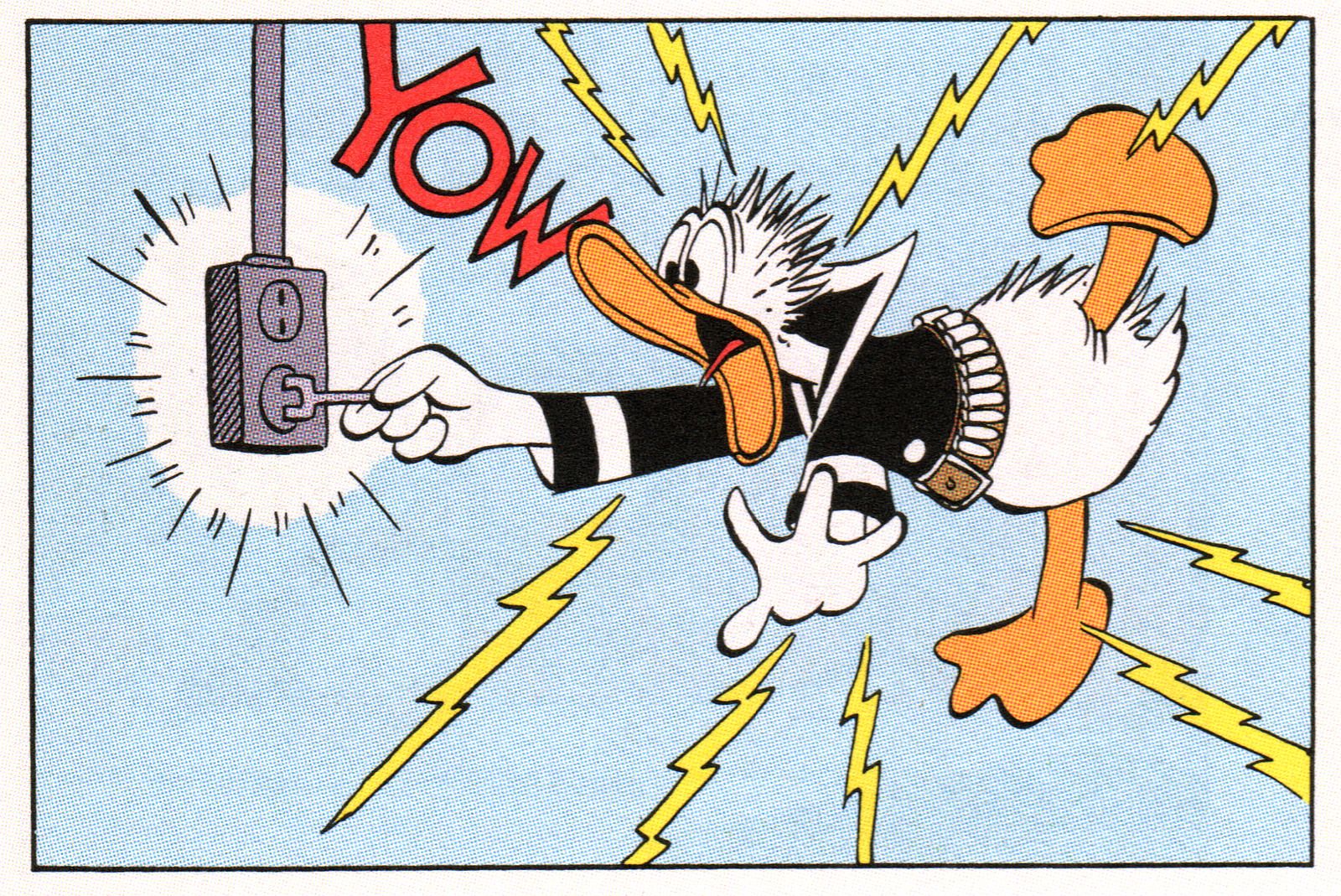
Meanwhile, people who have survived lightning strikes describe auditory sensations such as buzzing or humming, visual sensations such as a flash of light, and physical sensations like getting punched, kicked, or “hit in the head by a horse.”
How Do You Treat an Electric Shock?
If someone around you experiences an electric shock, it’s critical to take stock of the situation. If you touch someone who’s experiencing an electric shock without taking the right precautions, the shock can travel into your body too.
Electric shock can cause loss of consciousness or make it difficult for the person to let go of the power source on their own. If the person is still touching an electrical cord or appliance, turn off the power to the electrical outlet before approaching them.
Electrical energy can also travel through water and metal objects, so don’t approach them if the floor is still wet. Use rubber gloves or wooden objects to push them away from the source of electricity if you can do so safely.
If the person is unconscious, you can attempt cardiopulmonary resuscitation (CPR) while waiting for paramedics to arrive. However, don’t attempt to remove any burned clothing yourself.
What Is a Mild Electric Shock?
A mild electric shock is one that doesn’t cause any major symptoms or tissue damage. In general, currents of less than 50 volts are unlikely to cause major damage or death, but even low-voltage electrical circuits can cause injury in some situations.
The Merck Manual points out that a low-frequency alternating current may be more dangerous than a direct current because it “causes extended muscle contraction … which may freeze the hand to the current’s source and prolong exposure.”
Currents greater than 500 volts are considered “high-voltage” and are more likely to cause electrical burns, internal injuries, and cardiac arrest.
When Should I Go to the Doctor After an Electric Shock?
Whether or not you need to see a doctor depends on the severity of the shock. If you have any symptoms such as seizure, loss of consciousness, or an irregular heartbeat, then you should call 911 and go to the emergency department right away.
If you have any symptoms such as seizure, loss of consciousness, or an irregular heartbeat, then you should call 911 and go to the emergency department right away.
If you don’t have symptoms, but have underlying heart problems or are pregnant, then you should still see a doctor for tests such as an electrocardiogram (ECG).
Mild electric shocks may not require medical attention and can be treated at home the same way you would treat minor burns, such as using running water to cool the skin and covering the area with a sterile bandage.
Electricity Effects: Why Do I Feel Electricity In My Hands?
source
If you feel electricity in your hands but haven’t experienced an electric shock or been in contact with electricity, you may be feeling neuropathic pain instead. This is when your nervous system produces a sensation that feels similar to electric shock.
A number of conditions can cause this sensation, from anxiety disorders to traumatic nerve damage.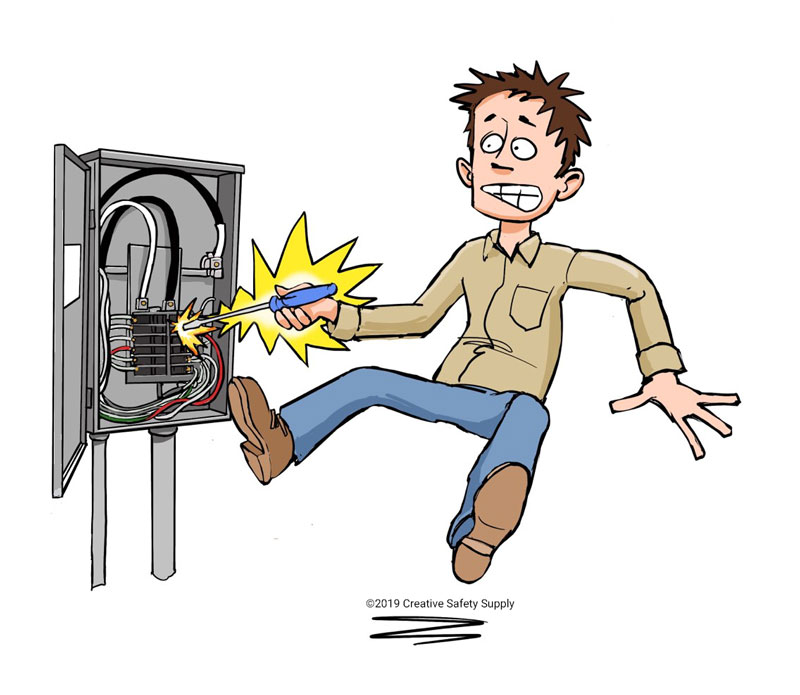 In more serious cases, it can be a manifestation of Lhermitte’s sign.
In more serious cases, it can be a manifestation of Lhermitte’s sign.
Can Electric Shock Damage Your Heart?
Yes, an electric shock can cause cardiac arrest, arrhythmia, ventricular fibrillation, and other issues. Heart damage may not be obvious right away, which is why it’s important to monitor anyone who’s experienced an electric shock for signs of heart trouble. If so, seek emergency care.
Electric shocks are more likely to cause heart damage if the current passes through the chest (i.e., arm-to-arm or arm-to-foot rather than foot-to-foot).
Can an Electric Shock Damage Your Brain?
Yes, an electric shock can damage your brain, especially if the current passes directly through it. Symptoms can include headaches, memory loss, and confusion.
That’s not the only thing to look out for: you can also injure your brain if you hit your head during a convulsion, or if blood flow to your brain is reduced.
Can You Talk While Being Electrocuted?
No, it’s incredibly difficult to talk during an electric shock. That’s because the electrical current interrupts signals from your brain and nervous system. It may result in muscle spasms, but you won’t be able to control your mouth enough to communicate. You might be able to call for help once you let go of the electrical cord or device that’s connected to the current.
That’s because the electrical current interrupts signals from your brain and nervous system. It may result in muscle spasms, but you won’t be able to control your mouth enough to communicate. You might be able to call for help once you let go of the electrical cord or device that’s connected to the current.
How Bad Is a 240-Volt Shock?
The severity of a 240-volt shock is depends on several factors, including the type of current and how much resistance there is. According to the National Library of Medicine, the body’s primary source of resistance to electricity is the skin, so dry skin offers more protection than wet or damaged skin.
A 240-volt shock may not “feel” any worse than a 120-volt shock, but either voltage can cause injury or death if particular circumstances are in place. The voltage of an electrical circuit or electrical appliance isn’t what determines the severity of the shock.
Fatal Results: Does Electric Shock Cause Death?
source
An electric shock can cause death, but not always. In fact, most people who receive an electric shock survive. The U.S. sees about 30,000 non-fatal shocks per year, but only 1,000 shock-related deaths, including 50 to 300 due to lightning strikes.
In fact, most people who receive an electric shock survive. The U.S. sees about 30,000 non-fatal shocks per year, but only 1,000 shock-related deaths, including 50 to 300 due to lightning strikes.
Most deaths from electric shock occur in the workplace, followed by adolescents getting too close to high-voltage electrical equipment. A related scenario is electric shock drowning, in which a person becomes paralyzed in the water due to electric shock and subsequently drowns.
Does Electrocuted Mean Death?
Technically, “electrocuted” and “electrocution” refer to someone dying of electric shock, but it may also be used to refer to someone seriously injured by electricity.
What Kills You, Voltage or Current?
Voltage measures the potential difference in energy between two points, while current measures the actual flow of energy. An electric shock from static electricity can involve several thousand volts, but because there’s not enough of it to sustain a current, even high amounts of static electricity won’t kill you.
On the other hand, even a low-voltage power outlet can kill you if contact with wet skin or a metal object allows it to deliver a steady current. So while it’s technically the current that kills someone, a high-voltage power line has a higher potential to deliver a fatal current.
Is Death By Electrocution Painful?
Yes, death by electrocution is painful since the electric current produces involuntary muscle contractions, burns, and ultimately cardiac arrest.
Exactly how painful it is depends on how strong the current is and how quickly the person loses consciousness. If the current goes directly to the heart, it will be less painful than if it travels slowly through the body and damages muscle tissue.
Why Does a Person Die of Electric Shock?
The main cause of death due to electric shock is the disruption of the heartbeat. Some currents stop the heart entirely, while others cause it to beat in an irregular rhythm. Even if the heart doesn’t stop beating, the person could still die due to other injuries, such as severe electrical burns or damage to other internal organs.
Even if the heart doesn’t stop beating, the person could still die due to other injuries, such as severe electrical burns or damage to other internal organs.
Protect Yourself From Electric Shock
source
Electric shocks can be scary, but there are plenty of precautions you can take to reduce the risk of electrical injury around your home. Start by ensuring that all of your electrical outlets have child safety covers, and that any extension cords and electrical appliances are put away when they aren’t in use.
If you plan to install new electrical devices in your home, such as an electrical vehicle charging station, hire a professional electrician to make sure it’s done right.
While you’re at it, why not see if you can get a better deal on your electricity bill? With Just Energy, you can get free nights or weekends, or choose a green energy plan to power your home with renewable energy.
Brought to you by justenergy.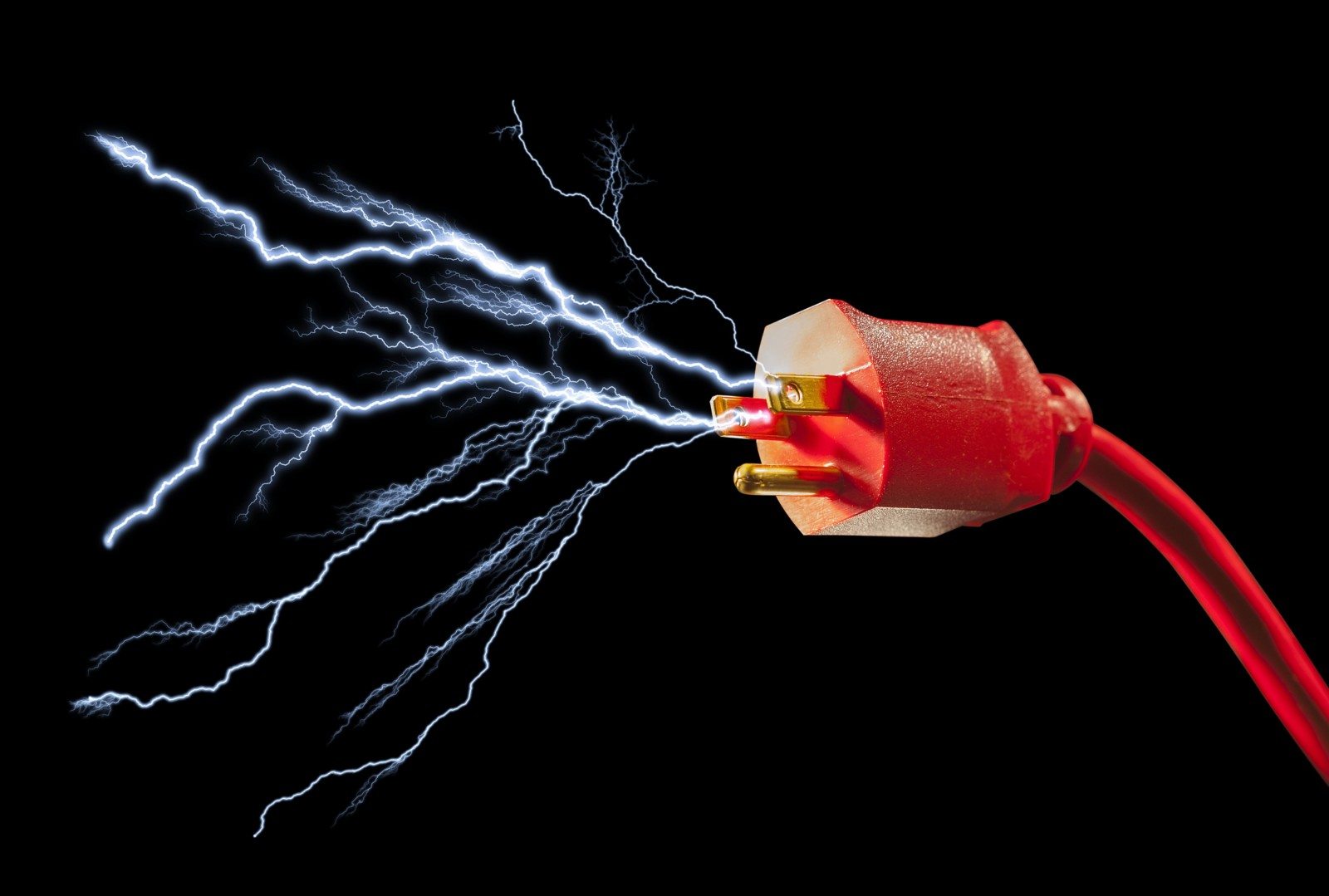 com
com
All images licensed from Adobe Stock.
Featured image:
How dangerous is 220 V mains voltage?
Russian homes use 220 volt electricity. If precautions and safety precautions are observed, this value is not dangerous to humans. What if something goes wrong?
Tags:
Interesting Facts
Pixabay
This voltage definitely becomes dangerous when the human body begins to transmit current further. It is dangerous to stand barefoot on a metal pipe and grab a current-carrying wire with your hand. It is also dangerous to stand in the water even in shoes and carry out electrical work. Many accidents have been described in the media when a person decided to use an electric hairdryer while bathing in the bathroom or check messages on a smartphone connected to the network at that moment.
Standard 220V outlets in homes are rated for 16 amps. At the same time, 100 milliamps (mA) of direct current is considered fatal when exposed to more than 0. 5 seconds. This may lead to cardiac arrest .
5 seconds. This may lead to cardiac arrest .
Even skin moisture content at the moment of electric shock and physical condition can be decisive. It is believed that the calculated resistance of the human body is at the level of 1000 ohms. It can decrease due to various factors, and then the damaging current will be stronger.
The most dangerous situation occurs when an electric current passes through the heart. This can happen if you take hold of the phase wire with your left hand. It is very dangerous to touch a bare wire with two fingers, because at this moment, during the passage of current, a muscle spasm may occur, and the fingers will firmly clamp this wire. At the same time, the time of exposure to electric current on the body increases many times, and this can lead to severe injury and even death.
ADVERTISING – CONTINUED BELOW
Electric shock can cause:
- cardiac arrest;
- respiratory paralysis;
- pain shock;
- paralysis of the central nervous system.

DC voltage up to 40 V cannot kill. At 220 volts, the risk of fatal injury increases to 20 percent. But this does not mean that every fifth electric shock leads to death.
Regarding the risk of electrical injury Several parameters are always important : the area of contact of current-carrying materials by the human body, the time of exposure to current and the risk of including a person in the current transfer process.
All this can be deadly if, during electrical work, you accidentally touch a phase wire with one palm and a grounded gas pipe or radiator with the other. Moreover, when touching the phase and neutral wires, only an unpleasant tingling can be felt with your fingers.
Electrical safety rules during work:
- turn off the breaker;
- work in rubber seals;
- use quality insulation materials;
- do not work in a damp room;
- work in rubber shoes or on a dry rubber mat;
- work with your right hand only, even if you are left-handed;
- do not work after drinking alcohol – it lowers the resistance of the human body and the risk of severe electrical injury increases.

iPhone killed a Russian woman with electric shock
Security
User
Security strategy
Technology
|
Share
A 24-year-old resident of Arkhangelsk was taking a bath and died from an electric shock after she dropped her charging iPhone 8 into the water. Doctors stated the fact of death from electric shock, and in Russia such a case is far from isolated.
Death by smartphone
Smartphone Apple iPhone 8 caused the death of a 24-year-old Russian woman Olesya Semenova from Arkhangelsk. According to the GizmoChina portal, the girl died from an electric shock while taking a bath – she dropped her smartphone into it, which was at that moment on the charge.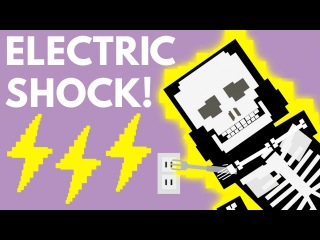
The body of Olesya Semyonova was discovered by her roommate Daria . “I screamed, shook her, but she was pale, did not breathe and did not show any signs of life. I was very scared. When I touched her and felt an electric shock,” she told the emergency operator. The neighbor also added that in the bathroom she saw the iPhone 8 itself, which continued to charge.
Cause of death confirmed
Paramedics, who arrived at the call of Daria, ascertained the death of Olesya Semenova as a result of electric shock. They confirmed that death occurred precisely after the phone connected to the charger fell into the bathroom.
Selfie photo of Olesya Semyonova. The picture on the right is clearly taken in bathroom
At the time of publication of the material, it was not known which device Olesya used to charge her smartphone. iPhone 8 comes with a 5W base power supply – 5V @ 1A.
“The tragedy once again reminds us that electrical appliances and water are incompatible. This also applies to any mobile device. If you just drown your smartphone, the worst thing that can happen to it is that it breaks. But when it is connected to the network, we see what the consequences can be, ”said representatives of the Russian Emergencies Ministry.
This also applies to any mobile device. If you just drown your smartphone, the worst thing that can happen to it is that it breaks. But when it is connected to the network, we see what the consequences can be, ”said representatives of the Russian Emergencies Ministry.
iPhone 8 is not to blame
What happened to Olesya Semenova does not mean that the problem is hidden directly in the iPhone 8 smartphone. As Russian practice shows, there is a chance of dying from using a smartphone in the bathroom, regardless of what model it is.
In February 2015, a tragedy similar to that in Arkhangelsk occurred in Moscow. A 24-year-old resident of the capital died from an electric shock by dropping a charging iPhone 4 into a bath of water. A year later, another such incident occurred in Moscow, but this time the victim was a 14-year-old girl. The iPhone model she used has not been identified.
It is better not to take smartphones into the bathroom
In June 2016, a charging smartphone that fell into a bathtub of water claimed the life of a 15-year-old Muscovite.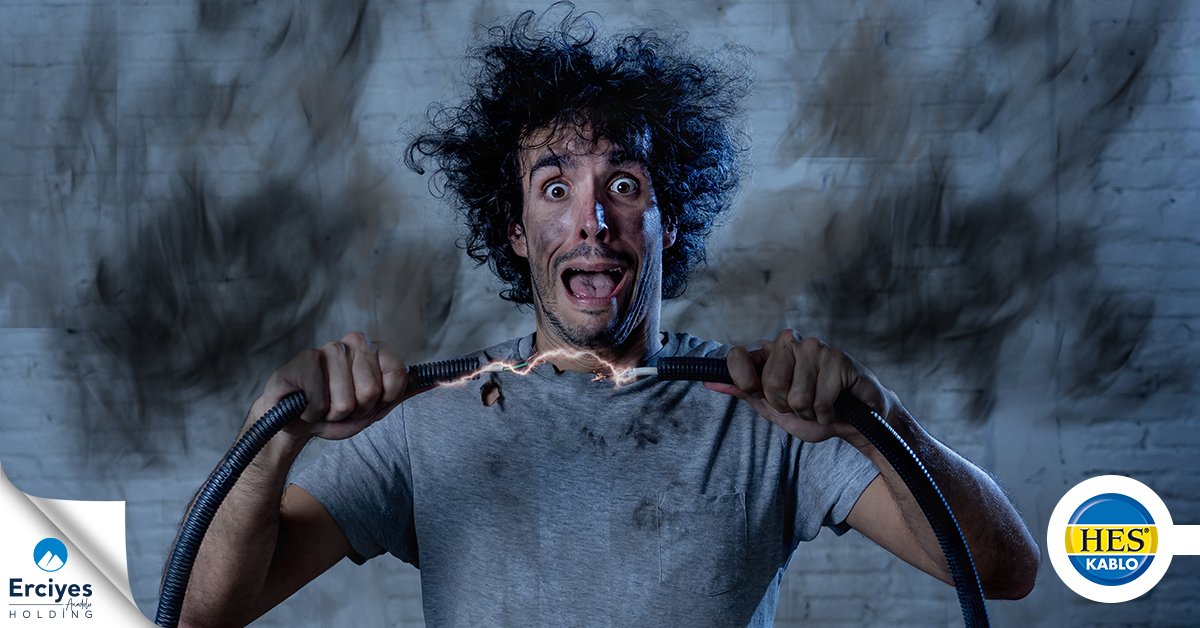 A burn from an electric shock was found on the schoolgirl’s shoulder, and a burnt smartphone was nearby. Its model is unknown.
A burn from an electric shock was found on the schoolgirl’s shoulder, and a burnt smartphone was nearby. Its model is unknown.
Sergey Kramarenko, Alfa-Bank: The future lies with the use of artificial intelligence in the field of information security
safety
This did not stop the series of such tragedies – in early February 2018, CNews wrote about the death of a 13-year-old girl from Serpukhov near Moscow. The investigation established that on the evening of January 31, 2018, the deceased went into the bathroom to bathe, taking with her a mobile phone (the brand was not installed), a charger and an electric extension cord in order to put the phone on charge right in the bathroom. The girl’s mother, who went into the bathroom after some time, found her daughter lying in the water without moving. The telephone, connected to the mains, was also in the water.
You don’t need a bath to die by gadget
Any mobile device, regardless of manufacturer, can kill its owner, even if kept away from the bathroom. For example, in July 2013, it became known about the death of a 23-year-old Chinese woman Ma Ai Lun (Ma Ai Lun) – she just touched her iPhone 5, which was on charge. In this case, it is worth noting that Ma Ai Lun’s hands were wet during the touch after a shower.
For example, in July 2013, it became known about the death of a 23-year-old Chinese woman Ma Ai Lun (Ma Ai Lun) – she just touched her iPhone 5, which was on charge. In this case, it is worth noting that Ma Ai Lun’s hands were wet during the touch after a shower.
iPhone 8 is not the only smartphone that killed its owner
In June 2019, CNews reported on the death of Bradley Island (Bradley Ireland) – he died as a result of a fire caused by a self-igniting Apple iPad tablet (model not disclosed). The cause of the computer’s self-destruction has never been established, and it remains unknown whether it was charging at the time of the fire.
Dangerous mobile equipment is produced by many large companies, and at least one such device is in the model range of the South Korean Samsung. This is the infamous Galaxy Note 7 smartphone, one of which spontaneously exploded in the hands of a six-year-old child, another set fire to the owner’s car, and the third set a fire in a residential building.

 Using body weight, push down hard and fast to administer compressions that are 2 inches deep. The aim is to deliver 100–120 compressions per 60 seconds.
Using body weight, push down hard and fast to administer compressions that are 2 inches deep. The aim is to deliver 100–120 compressions per 60 seconds.
